#fictional wildlife
Text

Kribble, as they're often called by the Grobblekin. A decapodal creature, whilst 3 pairs of its limbs seem vestigial, they're often used to hold onto their young, which are often tucked under their bellies.
They aren't shy of other animals or civilisation. Given how very little lives out on the land, there wouldn't be much to run from.
#shrimp#sheep#shreep?#fictional wildlife#creature#crustacean#decapod#look at that bug-eyed little idiot
30 notes
·
View notes
Text
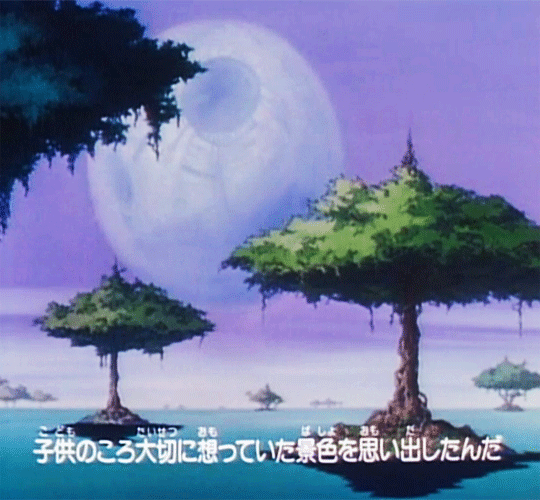

#GT#DBGT#DB#Dragonball#dragonball gt#grand tour#goku#trunks#pan#my gifs#goku gifs#trunks gifs#pan gifs#nature#wildlife#fictional wildlife#aesthetic#old anime#oldanime#oldanimeedit#old anime aesthetic#old anime style#90s aesthetic#90s anime#dbgt#akira toriyama#toei animation#gif#gifs#edit
18 notes
·
View notes
Text
here is a concept: time travel cop, fish & wildlife division
most of their job is dealing with the kinds of assholes who think black market tiger cubs are a great idea right up until someone gets mauled, except these are even bigger assholes with black market Smilodon cubs that they are even less equipped to care for
this is the most straightforward and therefore relatively headache-free part of their job, because it’s the same “put that thing back where it came from or so help me” song and dance every time
it’s also significantly less depressing than the trophy hunters who don’t even want an alive extinct animal. those are extra annoying because you have to undo the time travel that let them kill that poor Megatherium or thylacine or anklyosaur or whatever, and it’s always so much extra paperwork.
and those people suck, definitely, and have fully earned a stint in Time Jail. no question. but they still do not create anywhere near as much work as the obsessive hobbyists with their exhaustively careful best practices and worryingly good track-covering. also, weirdly, it’s almost always birds with them?
like. the guys who will flagrantly abuse Time Law to bird-nap breeding pairs just long enough to raise one clutch of eggs apiece, and return them seamlessly to their spots on the timeline. who are so determined to keep their pet (ha) projects going that no one even realizes what they’re doing until they have an entire stable breeding population of passenger pigeons up and running. who are now the reason that reps from six different zoos are about to start throwing hands right in front of you over who gets dibs.
those guys cause the most paperwork. and half the time they’re snapped up by the same zoo or wildlife preserve that gets their colony of ivory-billed woodpeckers or Carolina parakeets or — once, very memorably — giant fucking South Island moa, and they never even spend a day in Time Jail.
#purely notional fiction#time travel#actually the tropical fish guys are probably even worse than the bird guys#but they keep a lower profile so they’re harder to catch#time cops: fish & wildlife
14K notes
·
View notes
Text

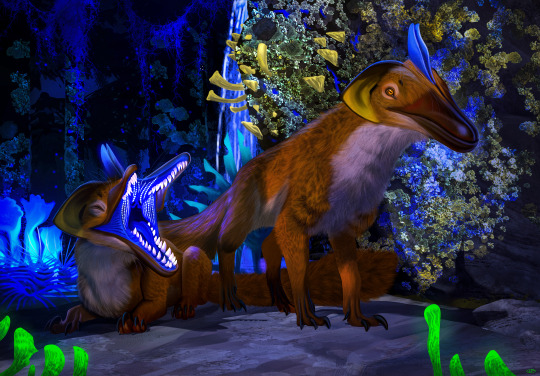




Here is another collection of exotic alien wildlife.
#my art#illustration#alien creature#alien#scifi art#science fiction#speculative zoology#speculative biology#speculative evolution#xenobiology#bioluminecent#bioluminescence#space#scifi illustration#wildlife art#wildlife#creature design
942 notes
·
View notes
Photo




Kings of the High Desert
A herd of strange creatures has congregated on this rocky outcrop. Known as Emperor Shinebacks, they often climb these rugged foothills to obtain access to cooling breezes and additional food sources. Their top-heavy tripodal stature prevents further ascension into the mountains, but it serves them well on more level ground. Reflective carapaces mitigate much of the sun’s harmful rays, and cooling flaps along their flanks dissipate excess heat. A shineback’s normal gait is rather clumsy, but when haste is needed they clamp all three legs together into a single monopod and bounce effortlessly across the desert at remarkably high speeds. This combined with their massive size (adults are over eight feet tall) and protective social behavior makes them almost impervious to attack. Almost…
#alien#alien world#astrobiology#worldbuilding#desert#sky#blue#mountians#speculative biology#space#extraterrestrials#wildlife#creature#creature design#science fiction#scifiart#biology#exoplanet#exobiology#artist#digitial art#Illustration#planet#drawing#conceptart
2K notes
·
View notes
Text





Worry not for the Nameless Red Disciple, they just went down to the river to chill with the river turtles!
#poorly drawn mdzs#nameless red disciple#tulu xuanwu#Not calling this mdzs as it *barely* counts#I will have this character appear in the story again but for now they are going on a personal journey to find themselves#and also hang with turtles#are they spiritual turtles? no they are just the normal variety of wise and beautiful semi-aquatic creatures#LSZ really just found one off to the side and picked it up. Once again I must bring up the consequences of disturbing wildlife#In this fictional setting its fun but don't actually pick wild animals up and hide them in your sleeves.#but it does hold true that girls LOVE turtles. Boys too. People who aren't either also love turtles#turtle is a universally loved entity#and now NRD is learning their secrets! They will be unstoppable!#meta note: This is part of my slow plan to dig myself out of my deep pit of inbox backlog.#I love all the messages but oh man I have been in survival mode for 2 months
268 notes
·
View notes
Text
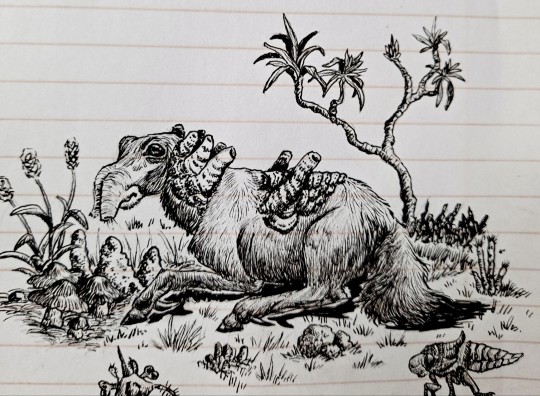
Although not the most common species of Hornblower, Horacio's Hornblowers are arguably the most well know representatives of this group. Large yet agile with a shoulder height of 2.12m, these ungulates can be easily identified by their independently mobile split trunks, another unique feature among hornblowers. Another unique feature of the species are their hooves, which have shifted from a cloven form to a single weight supporting toe, with the outer toe now sporting a heavily mineralized slashing blade capable of deeply lacerating the skin of most wildtype predators; and cutting a path through their native chokegrass thickets.
Moving on to the pipes for which their clade is named, these marvels of biological engineering are heavily reinforced with enamel and proteins, allowing all hornblowers nigh endless stamina as air constantly circulates through the surface area of their exceptionally complicated multi-chambered lungs, with Horacio's Hornblowers being exceptionally well suited to filtering air through their pipes- their native range in the Deeplands is exceptionally rich in noxious airborne substances, with sulfur dioxide in particular reaching concentrations that even the hardiest travelers may begin to struggle with- hence most explorers opting for integrated respiratory symbiotes when seeking out this elusive creature, prized as both genestock, and it's extremely acid resistant hide.
A small warning for those attempting to capture or study the Horacio's Hornblower- this animal possesses a unique lung microbiome rich in ricin producing bacteria. If startled, they WILL violently aerosolize ricin saturated mucus from all respiratory pipes. Take appropriate precautions. Not applicable to readers with a biological immunity to ricin, or exterior symbiosuits with said immunity.
#Annotated Guide for Casual Enthusiasts#Horacio's Hornblowers#ink illustration#ink art#wildlife illustration#speculative biology#speculative fiction#speculative evolution#scifi#Deepland Sog#body horrow cw#body horror
52 notes
·
View notes
Text

Man-Ape by Frank Frazetta; 1966, oil on academy board, 14 × 18 in.
#conan the barbarian#thak#horror#art#frank frazetta#60s#surreal#robert e. howard#fantasy#books#80s#1930s#oil painting#conan#painting#culture#graphic design#science fiction#retro#wildlife#arnold schwarzenegger#🗡
299 notes
·
View notes
Text
A bit about Arik fur colours and genetics
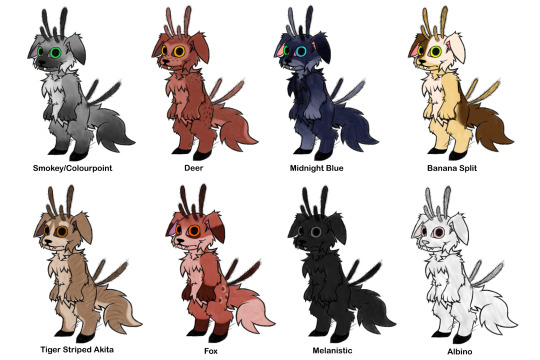
By default, Ariks have 6 "base" patterns + melanistic and albino variants. They're all seen above. Shades of the fur colours may vary slightly, but only in terms of being brighter, darker, high-contrast or dull. But all of the base patterns will still remain somewhat the same colour. For example, all Colourpoints will be a shade of gray and all Midnight Blues will have varying shades of dark blues.
The only exception is the Tiger Striped Akita pattern, which has also appeared as gray and almost blue before being mixed with other patterns via breeding. These natural gray and blue variants are incredibly rare, but they could explain why Midnight Blue exists.
Midnight blue is quite the interesting pattern. Some Ariks call it "The Mutt" despite it being a base pattern. (A mutt pattern would be anything that has a mixed pool of genes from two patterns, for example Deer and Colourpoint.) Midnight Blue is called a mutt pattern because it looks "ugly" and irregular. All base patterns have a strict rule about how many types of dots and coloured spots will go where. However, Midnight Blue randomises those. It is only considered a base pattern due to it's unusual shade of blue.
Mutt or base, an Arik fur pattern is always divided into different "sections" based on what colour goes where on the body. This is important when looking at how their fur genetics pass on to offspring.
Primary Colour — The base colour of the fur. This colour would cover the Arik entirely if you were to remove all patterns from it. The most dominant colour gene.
Secondary Colour — Most commonly a pattern, such as stripes, dots or splotches.
Tertiary Colour — Most commonly the colour of the stomach and/or cheeks.
Quartary Colour — Very rarely appears, most commonly the colour of the Arik's antennae, as seen on the Banana Split pattern. The most fragile colour gene, can easily "get lost" and won't inherit to the offspring or can be formed when the parents' colours mix.

Ariks usually get one single Arikit at a time. When two Ariks breed, their offspring will gain its fur colour and patterns depending on what the parents look like.
Most commonly the fur colour either switches patterns (As seen above, a Colourpoint pattern with Banana Split colours) or the parents' colours and patterns mix together, creating new mutt patterns. Colours may also mix together to create new shades.
Very rarely the Arikit turns out to be a perfect replica of one of their parents. However, this requires said parent to have a pure base pattern and to be the same sex as the Arikit.
#Yeiter#Arik#Bantar's Wildlife#Species Info#speculative biology#spec bio#fictional species#alien#alien species#alien biology#sophont
10 notes
·
View notes
Text
Sign-Ups Now Open for Bingo: May Edition!
Hey ther , sign-ups are officially open! So sign-up for your bingo card and get ready for a month filled with furry, feathery, and finned adventures with pets, wildlife, mythical creatures, and everything in between.
Over 50 different prompts were randomly generated to create unique bingo cards with 9 prompts each! There are two different types of bingo cards available.
Our Discord Server Link is: https://discord.gg/pCjeXgV4VV
#ao3#fanfic#FandomCommunity#CreativeWriting#DiscordServer#CharacterACharacterB#all fandoms#writing event#writing prompt#fanfiction#archive of our own#ao3 fanfic#fan fiction#fanfiction challenge#writing challenge#writing community#fanwork#fandoms#writing bingo#event#first ever#writers of tumblr#writers on tumblr#May#animals#pets#wild#wildlife#mythical creatures
7 notes
·
View notes
Photo
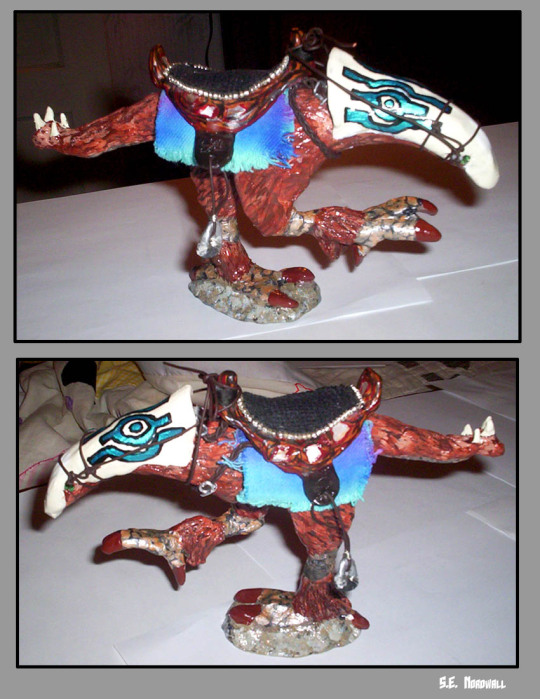
Noman’s Beast of Burden
[IMAGE ID: A hand-made sculpture of a Thomas / Toma from the anime series, Trigun. It is a brown bird-like creature - somewhat resembling a kiwi with a dinosaur-type spiked tail, a saddle and saddle-blanket complete with stirrups, a bone-like mask over its head done in abstract eye-designs and reigns. / END IMAGE ID]
A sculpture I did with Sculpey and various items many, many years ago. ‘98 anime style. It is actually the second sculpture I did one of one these creatures. It is... I don’t know... about 3 inches tall at the whithers, not huge, but not a miniature, either. The sculpture contains cloth - I actually think I used medical gauze that I’d dyed black for the padding on the saddle. The saddle blanket is cut from a destroyed old aqua-blue pair of shorts I’d had that I brushed some blue and purple ink on for extra color. There’s some broken mussel shell in there, little wire bits and leather lace, also some beadwork on the saddle. Yeah, I went all out for this thing. It sits on my bookshelf.
#trigun#classic trigun#toma#toma bird#planet gunsmoke wildlife#noman's land animals#alien creature#science fiction creature#big riding bird#sculpture#mixed media sculpture
37 notes
·
View notes
Text
has any human ever actually seen a salamander irl btw
#they're like a cryptid to me#i've known about them since early childhood. i've known what they look like and that they live in the mountains.#i honestly really really wanted to see one as a kid#and i've been in the mountains so many times. hiking on non-touristy trails that should be okay for seeing wildlife. i've spent so much-#-time in the mountain woods and canyons and rivers and quarries#and never did it feel like a place where you could realistically see that thing#i know all the theory. i studied fucking zoology. i know it's just a normal ass amphibian#but for some reason i just. can't imagine seeing it? can't imagine it existing somewhere and just walking around like that in the woods#it feels like a mythical thing#hell it feels like i'm being gaslit by everyone saying they're common in the mountains#how is that thing common. how is that thing even there#my brain riots when i try to imagine a salander just being irl#y. you feel me#i don't know how to explain it they just feel like a fictional thing that you can't actually meet or see or touch#ramble#hello welcome to my Salamander Thing that i've never actually told anyone about lol#i have zoology autism 😔#so i read everything i could on the topic since i could read and out of all the animals i learned about these fucking things just always-#-stuck out#like i'm reading a 'polish fauna' book and everything's normal and as expected then suddenly there's a bright yellow-black lizard there-#-that doesnt fit in with anything that lives here. what do you mean this thing exists HERE and youre telling me its common#where. where is it.
8 notes
·
View notes
Text
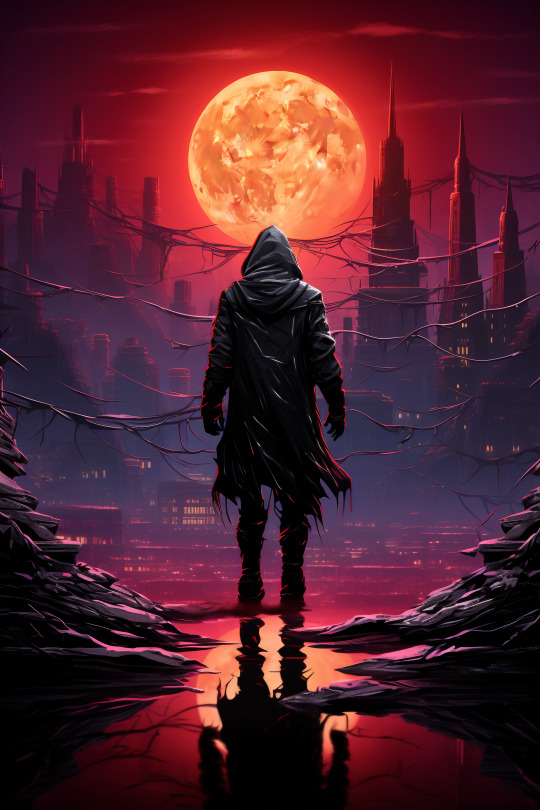
#dystopia#post apocalyptic#science fiction#sci fi and fantasy#scifi#science fantasy#landscape#curators#country music#music#wildlife#anime and manga#space#nature#scenery#anime art#digital art#digital illustration#digital drawing#digital painting#the amazing digital circus
2 notes
·
View notes
Photo
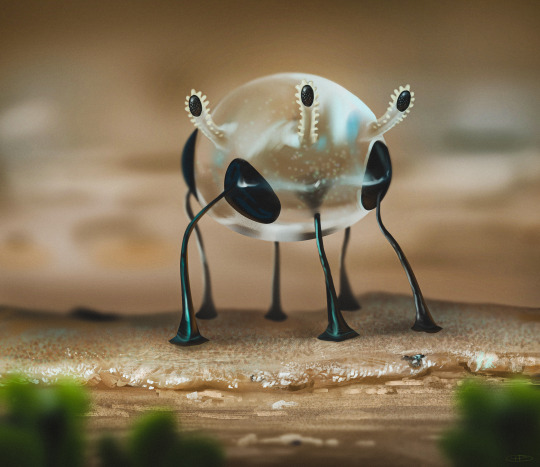
A picture of a stilted Peeper sifting through the sand on the hunt for delicious microbes.
#my art#alien#alien creature#scifi#science fiction#space#speculative zoology#Speculative Evolution#speculative biology#xenobiology#wildlife#cute#blob#fella#Illustration#creature design#small#organism
3K notes
·
View notes
Photo

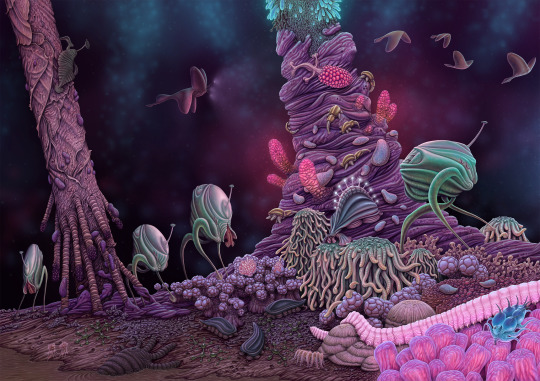


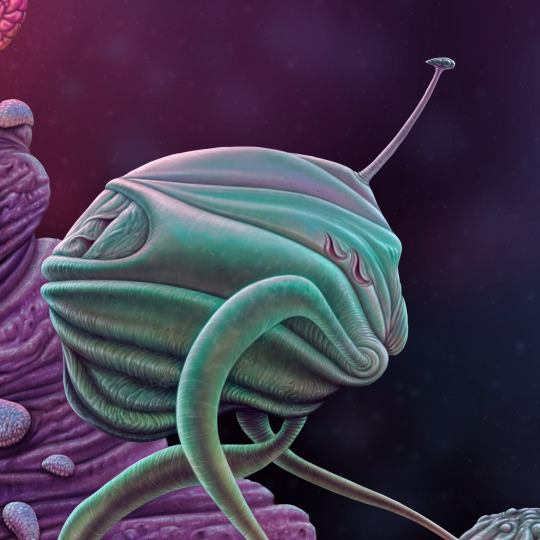
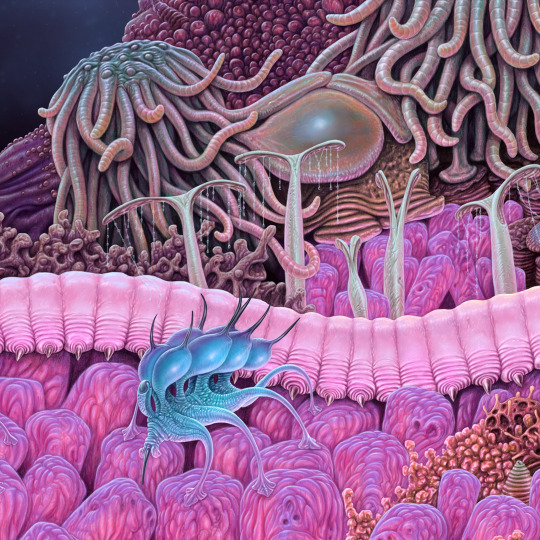
The Garden of Unearthly Delights
Biodiversity in Glow Forest Communities
Down on the floor of the Glow Forest, a startling array of lifeforms has evolved in the cool dark mist. The creatures that comprise the main structure of this biome are known as Vela, and they stretch skyward, consuming all the available sunlight and allowing none to escape below. This species won an evolutionary arms race long ago, and as a result its photosynthetic competitors were pushed to extinction. However being a successful monoculture has its disadvantages. Autotrophs form the base of the food chain in most environments, and now the Vela is the only one. This means it is now the main food source for many other species who would otherwise have more choices. Its main nemesis is the Stragulum. This amorphous creeping wrinkled blanket infects a new Vela pseudopod nearly as soon as it touches the ground. It rapidly takes hold and covers every inch of the surface, slowly digesting it. This in turn attracts a cadre of new organisms which consume the flesh of the Stragulum. Predators are then drawn to the area, and as the number of species grows, a self-perpetuating cycle of increasing biodiversity takes place. Eventually, the Stragulum becomes too much of a burden to the Vela and it severs its pseudopod in order to rapidly grow another nearby. But the biomass of the parasite still lingers for quite some time, feeding a plethora of bizarre and unique organisms scrambling for their share of the resources in this oasis of light amidst the darkness.
#alien#exobiology#astrobiology#art#creature art#space#speculative biology#evolution#exoplanet#bioluminescence#glow#wildlife#xenobiology#concept art#nature#scifiart#science#science fiction#purple#pink#dark
565 notes
·
View notes
Text
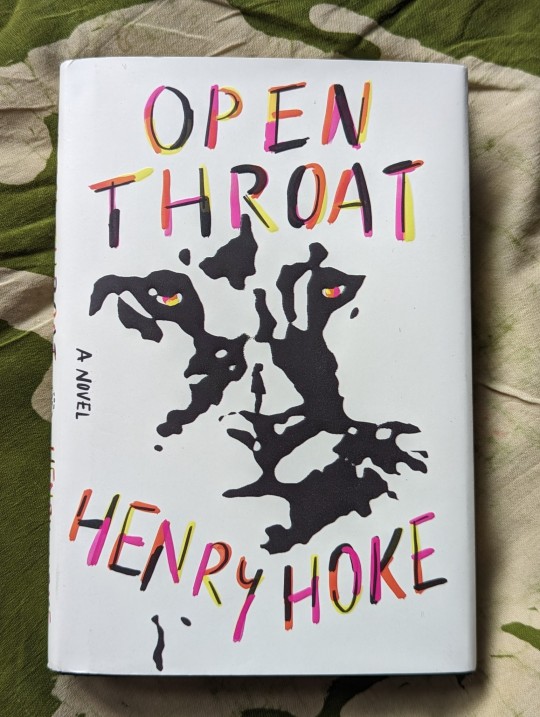
June 24, 2023:
this is practically poetry every other line is sublime or beautiful or funny or all three
it is from the point of view of a mountain lion
every book should be written like this it took no time at all to read I had a wonderful time
9/10
#WhatsKenyaReading
#whatskenyareading#books#reading#fiction#open throat#mountain lion#cougar#puma#big cat#cat#lgbtq+#gender questioning#gender#animals#first person pov#outsider pov#animal pov#pov#wildlife#wildfire#los angeles#LA#hollywood sign
3 notes
·
View notes